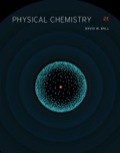
EBK PHYSICAL CHEMISTRY
2nd Edition
ISBN: 8220100477560
Author: Ball
Publisher: Cengage Learning US
expand_more
expand_more
format_list_bulleted
Question
Chapter 16, Problem 16.36E
Interpretation Introduction
Interpretation:
The ESR spectrum for the radical
Concept introduction:
The full form of ESR spectroscopy is electron-spin resonance spectroscopy. The ESR spectroscopy is used to observe those materials which contain unpaired electrons. ESR spectroscopy also works like NMR spectroscopy, but, in ESR, electron spin in spite of atomic nuclei spin gets excited.
Expert Solution & Answer
Trending nowThis is a popular solution!

Students have asked these similar questions
>
You are trying to decide if there is a single reagent you can add that will make the following synthesis possible without any other
major side products:
1. ☑
CI
2. H3O+
O
Draw the missing reagent X you think will make this synthesis work in the drawing area below.
If there is no reagent that will make your desired product in good yield or without complications, just check the box under the
drawing area and leave it blank.
Click and drag to start drawing a
structure.
Explanation
Check
?
DO
18
Ar
B
© 2025 McGraw Hill LLC. All Rights Reserved. Terms of Use | Privacy Center | Accessibility
Don't use ai to answer I will report you answer
Consider a solution of 0.00304 moles of 4-nitrobenzoic acid (pKa = 3.442) dissolved in 25 mL water and titrated with 0.0991 M NaOH. Calculate the pH at the equivalence point
Chapter 16 Solutions
EBK PHYSICAL CHEMISTRY
Ch. 16 - Prob. 16.1ECh. 16 - Prob. 16.2ECh. 16 - Prob. 16.3ECh. 16 - Prob. 16.4ECh. 16 - Prob. 16.5ECh. 16 - Prob. 16.6ECh. 16 - Prob. 16.7ECh. 16 - Prob. 16.8ECh. 16 - Prob. 16.9ECh. 16 - Prob. 16.10E
Ch. 16 - Prob. 16.11ECh. 16 - Prob. 16.12ECh. 16 - Prob. 16.13ECh. 16 - Prob. 16.14ECh. 16 - Prob. 16.15ECh. 16 - Prob. 16.16ECh. 16 - Prob. 16.17ECh. 16 - Prob. 16.18ECh. 16 - Prob. 16.19ECh. 16 - Prob. 16.20ECh. 16 - Prob. 16.21ECh. 16 - Prob. 16.22ECh. 16 - Prob. 16.23ECh. 16 - Prob. 16.24ECh. 16 - Prob. 16.25ECh. 16 - Prob. 16.26ECh. 16 - Prob. 16.27ECh. 16 - Prob. 16.28ECh. 16 - Prob. 16.29ECh. 16 - Prob. 16.30ECh. 16 - Prob. 16.31ECh. 16 - Prob. 16.32ECh. 16 - Prob. 16.33ECh. 16 - Prob. 16.34ECh. 16 - Prob. 16.35ECh. 16 - Prob. 16.36ECh. 16 - Prob. 16.37ECh. 16 - Prob. 16.38ECh. 16 - Prob. 16.39ECh. 16 - Prob. 16.40ECh. 16 - Prob. 16.41ECh. 16 - Prob. 16.42ECh. 16 - Prob. 16.43ECh. 16 - Prob. 16.44ECh. 16 - Prob. 16.45ECh. 16 - a The structure of 2 chloroethanol is usually...Ch. 16 - Prob. 16.47ECh. 16 - Prob. 16.48ECh. 16 - Prob. 16.49ECh. 16 - Prob. 16.50ECh. 16 - Prob. 16.51ECh. 16 - Prob. 16.52ECh. 16 - Prob. 16.53ECh. 16 - Prob. 16.54ECh. 16 - Prob. 16.55ECh. 16 - Prob. 16.56ECh. 16 - A microwave oven emits radiation having a...
Knowledge Booster
Similar questions
- What is the name of the following compound? SiMe3arrow_forwardK Draw the starting structure that would lead to the major product shown under the provided conditions. Drawing 1. NaNH2 2. PhCH2Br 4 57°F Sunny Q Searcharrow_forward7 Draw the starting alkyl bromide that would produce this alkyne under these conditions. F Drawing 1. NaNH2, A 2. H3O+ £ 4 Temps to rise Tomorrow Q Search H2arrow_forward
arrow_back_ios
SEE MORE QUESTIONS
arrow_forward_ios
Recommended textbooks for you
 Principles of Instrumental AnalysisChemistryISBN:9781305577213Author:Douglas A. Skoog, F. James Holler, Stanley R. CrouchPublisher:Cengage Learning
Principles of Instrumental AnalysisChemistryISBN:9781305577213Author:Douglas A. Skoog, F. James Holler, Stanley R. CrouchPublisher:Cengage Learning Organic ChemistryChemistryISBN:9781305580350Author:William H. Brown, Brent L. Iverson, Eric Anslyn, Christopher S. FootePublisher:Cengage Learning
Organic ChemistryChemistryISBN:9781305580350Author:William H. Brown, Brent L. Iverson, Eric Anslyn, Christopher S. FootePublisher:Cengage Learning

Principles of Instrumental Analysis
Chemistry
ISBN:9781305577213
Author:Douglas A. Skoog, F. James Holler, Stanley R. Crouch
Publisher:Cengage Learning

Organic Chemistry
Chemistry
ISBN:9781305580350
Author:William H. Brown, Brent L. Iverson, Eric Anslyn, Christopher S. Foote
Publisher:Cengage Learning